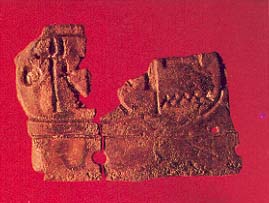Lachish—Key to the Israelite Conquest of Canaan?
018
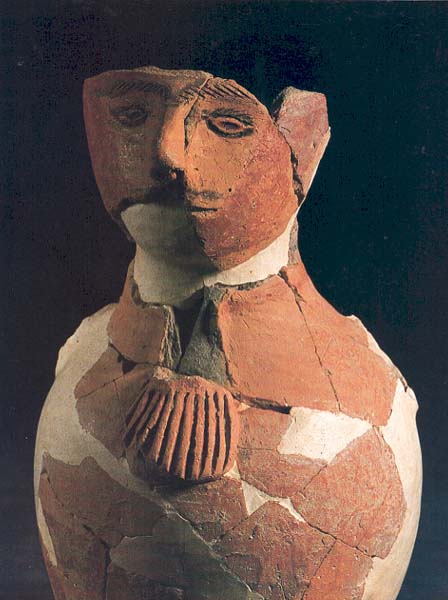
It is now more than seven years since my first report to BAR readers on the excavation at Biblical Lachish (“Answers at Lachish,” BAR 05:06). At that time, I primarily discussed Iron Age Lachish, the Lachish of the Judean monarchy. Judean Lachish was twice conquered and destroyed. Lachish Level III was conquered and destroyed in 701 B.C. by the Assyrian ruler Sennacherib. Lachish was rebuilt (Level II) and then conquered again and destroyed again in 588/6 B.C. by Nebuchadnezzar the 020Babylonian, as is known from the Bible (see Jeremiah 34:7) as well as from the excavations and from the famous Lachish letters found in the city gate.a
Now we have dug deeper. We have reached the levels of the Canaanite city and of Joshua’s time and earlier.
My previous article was titled “Answers at Lachish” and I was tempted to call this article “Answers at Lachish II,” because we have found many answers in our excavations of Late Bronze Age Lachish. But the fact is that this time some of our answers, especially our historical reconstructions, are less sure. Many questions remain. We are in a period where history is less certain and scholars themselves are often in disagreement about major points. But it is also a period when archaeological evidence is especially important and abundant, providing new evidence, almost daily, about this shadowy period of Israel’s origins.
Lachish is one of the key sites in the Bible’s account of the Israelite conquest of Canaan. Today it is one of the largest (30 acres) and most significant mounds of the Biblical period in the entire land of Israel. Ample water supply from deep wells, sufficient land for cultlvation and a location in the low hill country along the main route from the coastal plain to the Hebron hills all contributed to the prosperity and special importance of the city.
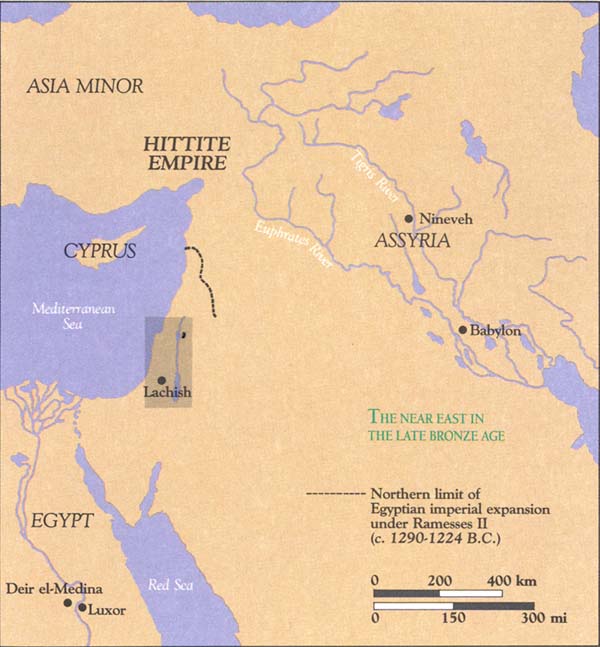
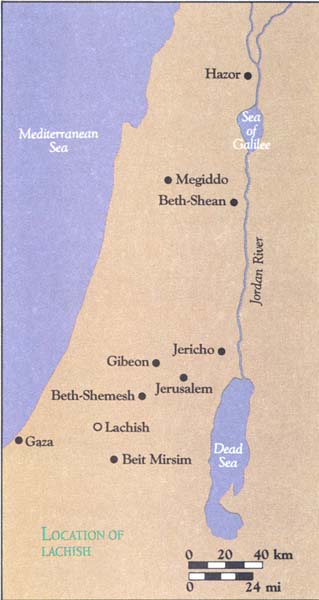
According to the Biblical account, Joshua conquered and destroyed first Jericho and Ai, and then made a treaty with Gibeon by which the Gibeonites agreed to serve Israel. In response, five Canaanite kings, including Japhia, the king of Lachish, formed an anti-Israelite alliance. This alliance of five Canaanite kings met the armies of Joshua on the field of battle in the Valley of Aijalon. With God’s help, Joshua roundly defeated the five kings. It was then that “the sun stood still” to allow Israel time to finish the attack. In the presence of his people, Joshua addressed the Lord:
“… Thus the sun halted in midheaven, and did not press on to set, for a whole day; for the Lord fought for Israel. Neither before nor since has there ever been such a day, when the Lord acted on words spoken by a man” (Joshua 10:12–14).
Following swiftly on this victory, Joshua proceeded to attack Makkedah, then Libnah, and then Lachish:
“From Libnah, Joshua proceeded with all Israel to Lachish; he encamped against it and attacked it. The Lord delivered Lachish into the hands of Israel. They captured it on the second day and put it and all the people in it to the sword, just as they had done to Libnah” (Joshua 10:31–32).
Lachish thus played a significant role in the Biblical story of the Israelite conquest; and it is clear that it was one of the most prominent cities in Canaan at the time. For the archaeological excavations at Lachish, three principal questions present themselves: First, what was the character and appearance of the Canaanite city that stood here at the time of the Israelite occupation? Second, can the archaeological data uncovered in the excavations shed any light on the Biblical story of the conquest and destruction of Lachish by the Israelite tribes? And third, does the archaeological evidence help us to understand the wider problems associated with the complex history of Canaan at that time, especially regarding the interrelationship between the Canaanites, the Philistines and the Israelites.
We believe that our excavations, and the excavations that preceded ours, provide significant, if sometimes tentative, answers to these questions.
Tel Lachish—which is almost certainly the site of ancient Lachish—was partially excavated long before we entered the field in 1973. Between 1932 and 1938, James L. Starkey led a large-scale British expedition that ended abruptly when Starkey was murdered by Arab bandits while traveling from Lachish to Jerusalem for the dedication of the Palestine Archaeological Museum.b
Starkey was a meticulous planner and had formulated a program of excavation that was to have extended over many years. Due to his tragic death, this program was brought to a sudden end and was never completed, although his distinguished assistant Olga Tufnell worked for 20 years on the data and finds, in the end producing an exemplary report covering the excavations that Starkey had completed.
Significantly, most of Starkey’s excavations were not on the tel itself. In the years he dug, Starkey concentrated his principal efforts elsewhere. He excavated many of the graveyards in the vicinity of the tel and he cleared a slope on the northwest corner of the tel to serve as a dump for excavations planned on the mound itself. While doing this work, he hit upon the massive fortifications built in the 17th century B.C., during the later part of the Middle Bronze Age (20th to 16th centuries B.C.). These massive fortifications extended down the entire slope of the tel ending, at the bottom, in an artificial fosse or dry moat. Here Starkey made one of his most important discoveries. In this moat or fosse, Starkey uncovered a Canaanite temple—known as the Fosse Temple—constructed at the beginning of the Late Bronze Age (16th century B.C.), built when the earlier fortifications apparently went out of use.
In addition, Starkey did limited work on the tel itself. He cleared some important remains down to the Persian period (sixth to fourth centuries B.C.) and Judean period (tenth to sixth centuries B.C.). He also cut a sectional trench in the northeast corner of the mound down to earlier levels, finally reaching bedrock. From all these excavations, he was able to identify six occupational levels or strata, from I to VI, beginning at the top. We have been able to confirm his strata and have continued using the same numbering system 021to identify these levels.
The sixth stratum (Level VI), he correctly identified as the last Canaanite city. It was destroyed by a violent fire. Our excavations, however, have uncovered an earlier Canaanite city—Level VII—that Starkey never clearly identified. This newly discovered Canaanite city requires some drastic revisions in Starkey’s archaeological conclusions.
Our excavations, sponsored by Tel Aviv University and the Israel Exploration Society, reached Late Bronze Age levels in three principal excavation areas: in a large sectional trench in our Area S; on the acropolis of the mound; and, surprisingly, in the area of the Judean entry gate complex.

Our main excavation area (Area S) is a large, narrow sectional trench at the western part of the tel. The use of such a trench was pioneered by Dame Kathleen Kenyon in her famous sectional trench at the tell of Biblical Jericho. By digging one ancient level after another in such a trench, the archaeologist obtains a sectional or vertical view of all the levels accumulated on the mound, right down to bedrock. This is what we did at Lachish. The work on this trench was supervised by Gabriel Barkay, who is familiar to BAR readers (“The Garden Tomb—Was Jesus Buried Here?” BAR 12:02).
In excavating this trench we first dug through a layer of Hellenistic and Persian remains, then the layer of the city destroyed by Nebuchadnezzar in 588/6 B.C. (Level II), then the layer destroyed by Sennacherib in 701 B.C. (Level III), then through several other layers of earlier Israelite occupation, preceded by a period when the site was abandoned. Finally, we got down to Level VI, the Canaanite city destroyed by a terrible fire.
Between 1981 and 1983, we removed the remains of Level VI. Penetrating still deeper we uncovered another, earlier Canaanite level that had also been destroyed by fire. We designated this earlier Canaanite city Level VII.1 During 1984 we carefully studied and analyzed the pottery recovered from these two Canaanite cities. One of the most significant results of this study was that we were forced to conclude that Starkey (and his assistant Tufnell) had attributed the last phase of the famous Fosse Temple, which I mentioned earlier, to the wrong city.
The reader will recall that Starkey found a Late Bronze Age Canaanite temple at the base of the mound built inside the fosse or dry moat which had been part of Lachish’s massive defense system built in the 17th century B.C., during the Middle Bronze Age. This Fosse Temple actually consisted of three superimposed, successive temples, known as Fosse Temple I, II and III. 022These temples were in use throughout the Late Bronze Age. The latest one, Fosse Temple III, was destroyed in a violent fire. Starkey assumed that Fosse Temple III was contemporaneous with the last Canaanite city (Level VI) since both the temple and the Level VI remains he uncovered on the tel had been destroyed by fire and no Canaanite remains were uncovered above either the destruction debris of Level VI or above the last Fosse Temple that had also been destroyed by fire. When we compared the pottery from Level VII to the pottery from the Fosse Temple destroyed by fire, it became apparent that the latest Fosse Temple, i.e., Fosse Temple III, was contemporaneous with the Level VII Canaanite city, not Level VI.2 We have to stress the archaeological and historical importance of this observation. Since its discovery 50 years ago, the rich 023Fosse Temple has become a key site for understanding Canaanite Lachish and the Late Bronze Age in Palestine in general. Thus, a change in the stratigraphical position of Fosse Temple III has widespread repercussions. Thus, if the Israelite armies destroyed the last Canaanite city (Level VI)—a subject we shall return to—they did not destroy the Fosse Temple, for that had already been destroyed at the end of the earlier Canaanite city, the city of Level VII.
Now that we have distinguished in well-stratified contexts between the two distinct Canaanite cities that existed one after another at Lachish, we have an excellent starting point for the detailed study of Late Bronze Age Lachish.
In our long, narrow sectional trench, we uncovered in Level III part of a large domestic building. Because the trench is quite narrow (27 feet wide), only part of the building was uncovered; it extends beyond the excavation area both to the north and to the south. The walls were built of mudbricks on a stone foundation. An open court was apparently paved with stones. The recovery of a large number of pottery vessels sealed beneath the destruction debris proved extremely important for dating purposes.
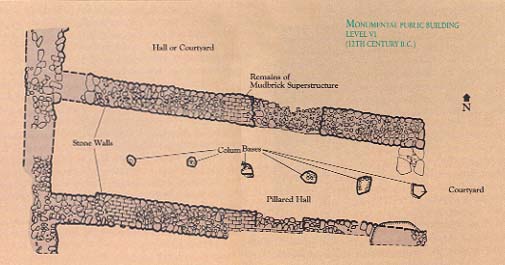
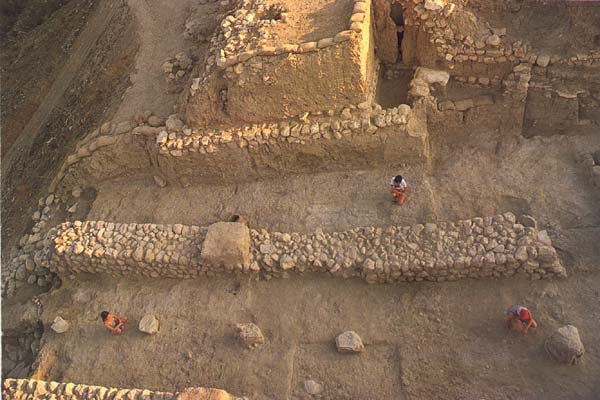
The latest Fosse Temple (Fosse Temple III) was contemporaneous with this domestic building. The temple, which also reflects Canaanite life in the Level VII city, was extremely well preserved because of its location at the bottom of the tel. It was protected over the millennia by a thick layer of debris eroded from the slope above. The ground plan of the last Fosse Temple was similar to that of the two Fosse Temples below it. The building consisted of a main hall, an antechamber in front of it and two smaller rooms at the back. The main hall was about 30 feet square. Four columns in the center supported the roof. Benches for priests or supplicants lined the walls.
The building was entered from the north. On the southern wall of the main hall was a raised platform and altar. Behind and above the platform a large niche was cut into the back wall of the hall forming the cellac of the temple.
This Fosse Temple yielded a variety of rich finds, sealed by the debris. Additional artifacts were found in pits outside the temple. The finds in this area included not only a large number of pottery vessels, mainly small bowls in which tributes or offerings were presented, but also scarabs, cylinder seals, beads, faience vessels and a large number of ivory objects.
After the fiery destruction of Level VII (probably at the end of the 13th century B.C.), the city was soon rebuilt (Level VI). But the Fosse Temple remained in ruins, never again to be raised. Apparently, it was replaced during the Level VI period, as we shall see, by a new temple on the acropolis of the mound.
The similarity of the pottery in Level VII and Level VI, as well as other cultural affinities, indicates that only a short period of time elapsed between the destruction of the earlier Canaanite city and the building of the last Canaanite city. Nevertheless, the layout of the city changed markedly, as did individual buildings. For example, the domestic building of Level VII partially uncovered in our sectional trench was replaced by a monumental public building. As I have already noted, the site of the Fosse Temple was abandoned and another temple was constructed on the acropolis of the city. The newly built temple probably replaced the earlier Fosse Temple as the central sanctuary of Lachish.
Strangely, it appears that neither of the two Canaanite cities (Level VII or Level VI) from Late Bronze Age Lachish was protected by a city wall or other fortifications such as existed in the Middle Bronze Age. The Fosse Temple was constructed in the fosse itself which had formed an integral part of the city fortifications during the Middle Bronze Age. This is a clear indication that these fortifications were no longer in use during the Late Bronze Age. Moreover, the buildings from Levels VII and VI we found in our sectional trench and the building from Level VI uncovered by Starkey in his sectional trench were all located on the periphery of the top of the tel, just where we would expect a city wall, if there had been one. There was no city wall around the edge of the city. It is quite possible that the buildings located around the periphery of the city were joined to one another, thus forming a closed ring of houses surrounding the city and protecting it from attack, but that is all. I shall later suggest why such minimal defensive measures apparently sufficed at Lachish during the Late Bronze Age.
Like the domestic building from Level VII that we uncovered in our sectional trench, the public building that replaced it in Level VI was only partially excavated by us because it too extended beyond the limits of our trench. For that reason, we have not been able to determine the complete ground plan of the building, but it included an open courtyard on the eastern side and two central halls between 45 and 55 feet long and 12 feet wide. One of these halls, which we call the pillared hall, had a row of five or six column bases extending along the central axis of the room. These column bases were embedded in the floor and consist of large flattish stones on which wooden columns probably stood. Like the earlier building, the walls were built of mudbricks on stone foundations, but these foundations are very thick, an indication that the edifice rose to a considerable height and may well have had a second story.
We were able to detect three different phases in the building’s history. While it originally must have served some public function in the Canaanite city, in its final phase it was used, like its predecessor in Level VII, solely for domestic purposes. Probably, at the end, refugees 028took shelter here and left their domestic pottery as evidence of their occupation. The finds in the building were all sealed by the destruction debris. Some of the more elegant finds must belong to the earlier phases of the building. These earlier artifacts reflect great prosperity and strong Egyptian influence. They include a unique scarab portraying a Pharaoh hunting, a piece of gold jewelry, an object covered with gold foil and two carved ivories. The domestic pottery, on the other hand, probably belonged to the people who settled in the building during its final phase, just before its fiery destruction.
Before discussing who might have been responsible for this destruction, let us look at the temple on the top of the mound.d This is the temple that may have replaced the Fosse Temple destroyed at the end of Level VII and not rebuilt. The Level VI temple built on the acropolis was located right in the center of the mound. We uncovered it beneath the foundations of the later edifice known as the Judean palace-fort. This temple was probably part of the palace complex of the Canaanite kings of Lachish, just as the temple built hundreds of years later on Jerusalem’s Temple Mount was part of the palace complex of King Solomon.
The Lachish temple on the acropolis of the mound must have been one of the finest and most luxurious buildings of Canaanite Lachish, but unfortunately it has been badly preserved. Robbed and then destroyed during the final destruction of the Level VI city, this Canaanite temple suffered further damage during the period of the Judean kingdom. At that time, stones from the Canaanite temple and the debris covering it were removed and used in the construction of the later Judean palace-fort. Nonetheless, enough remained to enable us, in a painstaking dig that lasted a number of years, to reconstruct this magnificent shrine and to obtain a reasonable idea of its character.
We also dug farther down, beneath the temple, to see whether it replaced an earlier temple from Level VII; in other words, we wanted to know whether there were two or more superimposed temples here, as was the case with the Fosse Temple. Unfortunately, the issue remains undecided. The walls of the Level VI temple did follow the lines of an earlier structure, but we found no clear evidence that the earlier structure was also a temple.
The Level VI temple was oriented from west to east, and consisted principally of three parts, an antechamber, a main hall and a cella. An annex of several rooms was attached to the north side of the main hall; a similar annex may have existed on the south side but this is now covered by the later Judean palace-fort, so it is difficult to tell. The walls of the Canaanite temple were built of mudbricks on stone foundations. The entrance was from the west. A stone staircase must have led from the antechamber to the main hall because the floor of the main hall is about four feet higher than the antechamber floor.
The main hall is nearly rectangular and measures about 49 feet by 40 feet—quite large, especially in ancient times. The floor is made of well-laid mudbricks. Two large, round limestone column bases, standing in the center of the hall, supported columns that in turn supported the roof. The column bases still exist but the columns themselves are gone. However, they were probably stone columns in the Egyptian style, crowned by flower-styled capitals. The roof was spanned by long wooden beams laid parallel to one another across the main hall and supported by the central columns. The charred remains of these roof beams were found lying on the floor. We analyzed them and they turned out to be cedar of Lebanon, the famous and expensive wood imported from the hills of Lebanon that was also used in Solomon’s Temple much later. In the eastern part of the main hall, we found numerous fragments of painted plaster that once decorated the walls of the Canaanite temple and were perhaps used on the wooden ceiling as well. Many of these fragments were found adhered to each other. Separating and preserving them proved to be difficult. The fragments are in many colors—black, white, red, yellow and, especially, a beautiful light blue. Some fragments show traces of pattern, but not enough to describe.
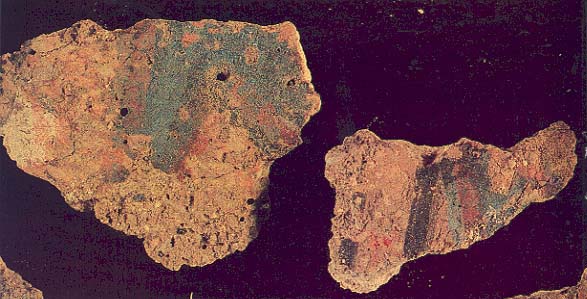
The entrance from the main hall of the temple to the northern annex was lavishly decorated with beams of cedar of Lebanon. Two round wooden posts, each about five inches in diameter, flanked the doorway. At the northeastern corner of the main hall was a small storeroom that contained many pottery vessels. A plastered installation about four feet high in the 029southeast corner of the main hall was probably used to hold water.
Three round chalke column bases were arrayed along the eastern wall of the main hall. Each of the three bases was attached to the wall by a plastered brick pilaster or pier. These column bases originally carried tapering octagonal columns, also hewn of chalk; they were removed and broken when the temple was robbed, but we found some remains in the course of the excavation. Each column was crowned by a square capital. Each side 031of the capital was a continuation of one of the column shaft’s eight facets; this form of the eight facets of the column continued into the capital. Each column, including its base and capital, was only about five and a half feet high. A three-inch hole was drilled into the top of each capital in order to secure it at the top. The purpose of these columns is a puzzle. Obviously, they did not serve a constructional purpose; they are too short. One attractive suggestion is that the three columns—as well as the column bases—were connected with brick pilasters to the eastern wall of the main hall of the temple, thereby forming two niches along the wall between the three columns. Here sacred statues or stelae might have been placed, facing the hall.
A monumental staircase of well-hewn chalk stone slabs, built against the eastern wall of the main hall, led up to the raised cella. The bottom slab of the staircase was more a threshold than a step, since it was wider and lower than the others; indeed it is nearly flush with the level of the brick floor. A circle 22 inches in diameter is engraved on the right side of this threshold-step, probably to mark the position of a stand or the like. Unfortunately, some of the slabs in the staircase were pulled out and carried away after the temple was destroyed. The four lowest steps were found complete, but the fifth and sixth steps were partly removed. The seventh step is missing altogether. The four lower steps were flanked on each side by a low parapet, made of two well-hewn stone slabs. The upper end of the parapet rested on a round column base, next to the wooden column that originally stood on the column base. These columns must have supported a small roof or canopy covering the staircase.
The cella of the temple unfortunately was badly preserved. It is difficult even to reconstruct its plan. The staircase just described led onto a plastered landing at the entrance to the cella, but that is almost all we know.
The rich temple furnishings were probably vandalized before the temple was set on fire. Relatively few finds were recovered. However, we discovered in situ six broken pottery stands placed in a row along the back wall of the storeroom. Other significant finds strewn about the floors included fragments of alabaster and faience vessels, fragments of ivory plaques or small bowls, painted fragments of ostrich shells, beads and pendants, pieces of oxidized iron (a rare and expensive commodity at the time) and many pottery offering bowls.
Our prize find, however, was what we call the “Lady Godiva” plaque. It is a thin gold sheet that we found crumpled and torn into five pieces. It has been straightened and put back together, and is now on tour in the United States (See BAR’s review of the exhibit, “Ancient Israelite Art Sparse in Impressive Show at Met,” BAR 12:06). Measuring about 7 ½ by 4 ½ inches, it was probably originally attached to a wooden plaque or sewn to a piece of leather or textile. The scene depicted on it is shown in high relief, achieved by pressure applied to the reverse side of the gold sheet and accentuated by grooving. A few details were shown with the aid of insets on the front, probably colored stones that are now missing. The plaque portrays a naked goddess standing on a horse. Her headgear is composed of vertical leaves resembling a flower, with two horns at the bottom. In each hand, she holds two lotus flowers with long stems.
Finally, in a room on the side of the main hall we found a number of well-dressed stone slabs inscribed with graffiti. The most significant graffito portrays a standing god, brandishing a lance with both his hands.
Christa Clamer, of Israel’s Department of Antiquities, has made a meticulous study of this god as well as of the naked goddess on the gold plaque; she has concluded that the god and goddess are both associated with the cult of the Egyptian-Canaanite divinities Qudshu, Asherah-Astarte and Resheph. This may, of course, be taken as an indication that the cultic rites of these deities were performed in the temple.
To summarize, the temple consisted of three elements located one behind the other—the antechamber, the main hall and the cella. The entrance to each element was located along a single, straight axis oriented from west to east; each element of the temple stood on successively higher ground: A staircase led up to the main hall and another staircase led up to the cella. Two massive columns in the center of the main hall supported the roof.
These same distinguishing features have been found, in part, in other temples as well, especially at the contemporaneous Canaanite temple in Beth-Shean. As I hinted earlier, these same architectural principles—except the orientation and the two central columns—were also used in Solomon’s Temple in Jerusalem. Thus, it seems that our Canaanite temple at Lachish was built according to a plan that later served as a prototype for Solomon’s architects. The two central columns in the main hall—which also were found in the temple of Beth-Shean—serve to illustrate the Biblical account of the Philistine temple of Dagon in Gaza, which Samson pulled down by the two central columns (Judges 16:23–30).
The plan of this Canaanite temple at Lachish seems to have originated in Egypt. Similar temples have been uncovered at Deir el-Medina near Luxor, and also at Tell el-Amarna. Deir el-Medina was the village of the ancient Egyptian workmen who cut the tombs of the Pharaohs in the Valley of the Kings. At Deir el-Medina, Chapel G, among others, consists of an antechamber, main hall with two central columns and a cella; the entrances and their staircases are aligned along a central axis. Various other characteristic features in our Canaanite temple at Lachish were adopted from the Egyptians—the octagonal columns, the shapes of the column bases and capitals, the staircase and its parapet, the brick-paved floor and the painted plaster. In short, our Canaanite temple at Lachish (as well as the 034contemporaneous Canaanite temple at Beth-Shean) displays strong Egyptian influence.
Before considering what this Egyptian influence indicates, let us examine our third excavation area,f where we found Late Bronze Age remains which turned out, in a way, to be the key to the entire excavation of the Late Bronze Age levels. This excavation area was the gate complex to the Judean city which was destroyed by Sennacherib in 701 B.C. We had no thought that this area would have any significance for our study of the Late Bronze Age city. Our sole interest here was in investigating the Judean remains. We decided to open a narrow trench in one of the chambers of the Judean gate in order to examine the area below floor level to study the foundations of the gate. We reached the bottom of the foundations only after digging more than ten feet below the floor level. There we discovered that the foundations of the gate were laid on a plastered floor dating to the tenth century B.C. (Level V). We decided to make a further probe beneath this floor in order to check the date and its stratigraphic position before discontinuing work in this trench altogether.
Once we penetrated beneath the material that made up the plastered floor, we unexpectedly encountered destruction debris and pottery from Level VI, the last Canaanite city. And here—in the most unexpected place and to our utter surprise—we found a cache of bronze objects lying buried and sealed beneath the destruction debris of Level VI.
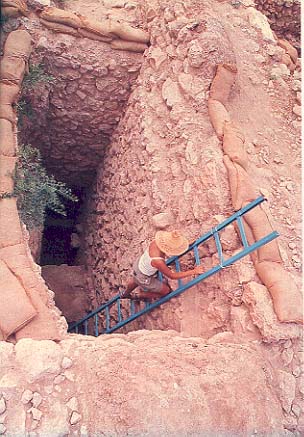
This cache included a peculiar assortment of broken or defective tools—a pair of tongs, a knife blade, an axe or adze, two borers or awls. Because they were all broken or defective and all made of bronze, perhaps the collection can be explained as a scrap-metal collection destined for remelting and recasting.
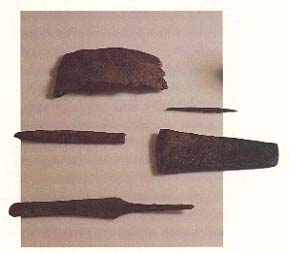
One of the tools had an unusual shape; indeed, its original shape, size and function are still obscure. It was an oblong plaque with a handle welded into its back. Now broken, the plaque is six and a half inches long. When the object was cleaned in the laboratory, we found that it contained a cartouche on it. A cartouche is a royal ring surrounding hieroglyphics that spell the name of Egyptian royalty. In this case, the cartouche contained the name of a powerful Pharaoh of the 20th Dynasty, Ramesses III.
Since the object bearing his name was sealed beneath the destruction debris of Level VI, this destruction could not have occurred prior to the accession of Ramesses III to the Egyptian throne. Most Egyptologists now date Ramesses III’s long reign to 1182–1151 B.C. Some time must have passed after his accession in 1182 B.C. to enable our object to have been cast in bronze, possibly imported to Lachish, and to have been used, then broken and finally discarded and set aside in this cache of defective or broken bronze objects. This cartouche is evidence that Level VI, the last Canaanite city at Lachish, was destroyed sometime around 1150 B.C. or even later.
The discovery of the cartouche of Ramesses III forced us to reexamine many long-held ideas and concepts. Until now the final destruction of Canaanite Lachish 035was considered to have occurred in the 13th century B.C. The great William F. Albright thought that the destruction of Canaanite Lachish could be pinpointed to “about the year 1231–30, or a very little later.” This date was accepted by many other authorities. Now we have to reduce this date by 80 years—to about 1150 B.C.—or even more. What are the implications of this drastic change?
Lachish Level VI was a large and prosperous Canaanite city, with characteristic Canaanite pottery, art and culture. It is also clear that this city maintained important connections with Egypt. We have already described the lavishly decorated and equipped temple which reflects so much Egyptian influence, despite the fact that nothing in the building indicated it was dedicated to an Egyptian deity. In addition to the temple, various other finds, such as scarabs and the cartouche of Ramesses III, demonstrate strong Egyptian influence.
In this respect I should mention one significant find that was uncovered by Starkey in a tomb contemporaneous with Level VI at the foot of the mound. The tomb contained two anthropoid clay coffins of the type known from a number of places in Palestine and Egypt during this period, notably Beth-Shean and Deir el-Balah south of Gaza. These coffins, cylindrically shaped, with the lid featuring a human face, represent an Egyptian funerary custom, and their use at Lachish fits the Egyptianized character of the Level VI city. One of the coffins bears a crudely executed painted depiction of two Egyptian deities, as well as a pseudo-hieroglyphic inscription written by an unskilled local scribe who was trying to copy the ancient Egyptian formulae. The clay of one of the coffins was analyzed by neutron activation in order to establish its place of manufacture, and it apparently originated in the region of Lachish.
Nothing at Lachish is more indicative of Egyptian presence, however, than four bowl fragments inscribed in Egyptian hieratic script, found out of context by Starkey in the foundation fill of the later Judean palacefort. These inscriptions have recently been studied afresh by Orly Goldwasser, an Egyptologist at Hebrew University, in conjunction with similar hieratic bowls from Tel Sera‘ in southern Israel. The Lachish bowls (and the Tel Sera‘ bowls) document the smw, the harvest tax, paid to an unidentified Egyptian religious “institution.” This Egyptian religious institution was probably associated with a local temple, such as our Level VI temple. According to Goldwasser—and she seems to be correct—the recording of the payment of the harvest tax on votive bowls in the temple reflects the economic exploitation of southern Canaan by the Egyptian authorities via the religious establishment. This may very well mean that Canaanite Lachish was under Egyptian suzerainty at the time, as was much of southern Canaan.
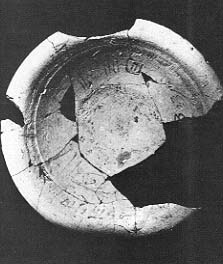
The strong ties between the Egyptian administration and the Level VI Canaanite city may well explain the city’s great prosperity. The Egyptian presence may also explain why the Level VI city (and the earlier Canaanite city of Level VII as well) did not require any fortifications to defend it: It was “protected” by Egypt. The data from Lachish and from many other sites in Canaan are consistent, providing additional support for one another and allowing us to conclude that Canaanite cities continued to prosper during this period despite the fact that the area was still part of the Egyptian empire, not only during the reign of Ramesses III, but even later, during the brief reigns of his successors, Ramesses IV (1151–1145 B.C.), Ramesses V (1145–1141 B.C.) and Ramesses VI (1141–1134/3 B.C.). During this period, Egypt apparently still had effective political, economic and military control over most of the country. The strongholds of Megiddo and Beth-Shean in northern Canaan perhaps marked the northern edge of Egyptian-held territory at the time. Egyptian hegemony was badly weakened during the third quarter of the 12th century B.C. The sudden destruction of Lachish Level VI was probably the result of the Egyptians’ loss of control over southern Canaan. Without Egyptian protection, unfortified Lachish became easy prey to the enemy.
But who was the enemy?
Lachish Level VI was razed in a violent destruction accompanied by fire. Traces of the conflagration could be seen everywhere that Level VI remains were uncovered. The destruction was apparently complete, and the population liquidated or driven out. Following the catastrophe, the site was abandoned and remained desolate until the tenth century B.C.
The circumstances of the city’s destruction were vividly illustrated in the ruins of the large public building in our large sectional trench (Area S). In the end the building was apparently turned into living quarters, perhaps for refugees from outside the city who fled their homes in the face of the disaster that eventually destroyed Lachish. On the floors, sealed beneath the building debris, we found human osteological remains—bones of an adult female aged 40–50 years and an eight-year-old child, as well as two skeletons: one of a two- or three-year-old child and the other of an infant of six to eight months old. Professor Patricia Smith, an anthropologist at Hadassah Hospital in Jerusalem, who is studying these remains, has concluded on the basis of the position of the skeletons on the floor, that “the child had either been thrown down on its face, or possibly died while crawling along the ground … the infant was thrown or fell onto the ground.” Apparently, these young children were trapped and then crushed under falling debris while trying to crawl out. According to Professor Smith, the excellent state of preservation of the skeletons suggests that they were covered by debris shortly after death.
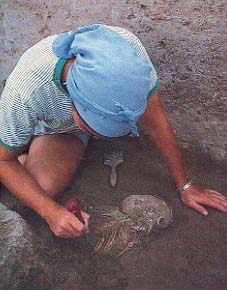
All the evidence points toward the destruction of Level VI by a powerful and resolute enemy. But again we must ask who? Unfortunately, archaeological data do not provide any affirmative clues as to the identity of that enemy or to the immediate circumstances surrounding the city’s downfall.
036
At this point, we come back to the question raised at the beginning of this article: according to the archaeological data, how likely is it that the destruction of the last Canaanite city of Lachish (Level VI) can be attributed to the Israelite armies as related in the Book of Joshua?
First, we must consider the possibility—contrary to the Biblical traditions—that Canaanite Lachish was not destroyed by the Israelite tribes, but, was instead, as suggested by Olga Tufnell when she studied the remains of Level VI, destroyed during a punitive raid by an Egyptian Pharaoh. This theory may now be rejected, because the new data we have uncovered indicate Lachish’s dependency on and alliance with Egypt, rather than a state of enmity between the two. It would be difficult to construct a believable scenario in which a Pharaoh of the 20th Dynasty would attack and utterly destroy Lachish Level VI.
What about the Philistines? Could they be the enemy that destroyed Canaanite Lachish?
A priori, the Philistines are one possibility. But a careful consideration of this possibility requires some background.
About 1200 B.C. or slightly later the Sea Peoples, who probably came from the Aegean world, swept across the Near East. In a famous battle depicted on the walls of Ramesses III’s mortuary temple at Medinet Habu near Luxor, the Sea Peoples fought against the armies and navy of Ramesses III in an effort to invade Egypt. But they were repulsed and defeated.
Eventually, one of the Sea Peoples’ tribes known as the Philistines settled along the coast of southern Canaan, as related in the Bible; other tribes of Sea Peoples settled farther north on the Canaanite coast. Material remains of the Philistines have been uncovered in many places; their culture is distinguished primarily by the beautifully decorated Philistine pottery. An excellent summary of the Philistines and their material culture has recently been presented to BAR readers by one of the world’s leading authorities on Philistine culture, Trude Dothan.3
Significantly, no Philistine painted pottery has been found at Lachish either by Starkey or by us, with the exception of a few Philistine sherds discovered in a cave on the slope of the tel, near the northeast corner of the mound. This cave was used during the Late Bronze Age, but Iron Age pottery was also found in it, indicating that the cave must have continued in use after the destruction of the Canaanite city of Level VI. Thus, although the Philistine sherds could have belonged to Level VI, it is more likely that they were 037a later intrusion, perhaps left in the cave (which is located not far from the city’s water supply) by someone wandering around the abandoned tel and taking shelter there. The crucial fact is that, for all practical purposes, Philistine pottery is completely absent from Lachish.
This fact has far-reaching implications. Lachish is quite close to the coastal plain, where the Philistines first settled. Lachish was thus close to the very distribution center of Philistine pottery. Two major Philistine cities, Tel Zafit (Biblical Gath) and Tel Miqne (Biblical Ekron) are but a short distance north of Lachish. Philistine painted pottery has been found at sites even farther inland than Lachish—for example, at Tel Beth-Shemesh, at Tel Eton and at Tell Beit Mirsim. Considering the geographical position, the size and the prosperity of the Level VI Canaanite city at Lachish, it is difficult to imagine that nearby Philistine pottery, which was being diffused inland from the coastal plain, would not be found in appreciable quantities at Lachish as well. Yet, apart from the few Philistine sherds found in the cave nothing was found. The only logical conclusion is that the absence of this distinctive pottery in Level VI demonstrates that Lachish simply was not settled at the time that painted Philistine pottery was being produced. Therefore, the Philistine pottery must have appeared in this region only after the destruction of Lachish Level VI, which we have dated to c. 1150 B.C. or slightly later. To put the matter differently, the destruction of Lachish Level VI marks the earliest date for the appearance of Philistine pottery in this region.
The evidence from Lachish is admittedly negative—it is based on the absence of Philistine pottery—but it is so absolutely negative that it provides a sound basis for concluding that it was not until after about 1150 B.C., and probably slightly later, that Philistine painted pottery appeared anywhere in the country. Similar conclusions have recently been reached by other scholars such as Amihai Mazar and Eliezer Oren based on their own excavations and studies. It thus follows—if the introduction and use of Philistine painted pottery is considered the primary criterion—that the settlement of the Philistines in southern Canaan occurred only after Egyptian control began to disintegrate following the death of Ramesses III in 1151 B.C.; or even two decades later, following the complete disintegration of Egyptian control.4 This conclusion obviously requires a revision in Trude Dothan’s judgment that the Philistines settled in Canaan about 1200 B.C.
038
The idea that Level VI might have been destroyed by the Sea Peoples was considered by Tufnell and found very attractive. Ugarit and Alalakh, the two large Canaanite centers in northern Syria, were razed and abandoned at the end of the Late Bronze Age; these destructions are generally attributed to the invading Sea Peoples, and it is tempting to compare these destructions with that of Lachish Level VI. The contention that Canaanite Lachish met its end by the hand of the Sea Peoples is based on a wider historical reconstruction—that the invasion of the Sea Peoples was a prime factor in the collapse of Egyptian authority and military control over southern Canaan, which left unfortified cities such as Lachish completely vulnerable. This remains a possibility, even though the Philistines had not yet introduced their distinctive pottery into this region.
But let us now consider an alternative scenario—that Canaanite Lachish was destroyed by the Israelite tribes, as strongly advocated by Albright. The archaeological data indeed fit the Biblical description: a large Canaanite city destroyed by fire, the absence of fortifications enabling the conquest of the city on the second day of the attack, complete desertion of the razed city, explained by the annihilation of the populace. On the other hand, the motive for the destruction remains obscure, since the Israelites apparently had no interest in occupying the site, which remained unsettled after this destruction until about the tenth century B.C. Indeed, Israelites did not settle anywhere in the region, as shown by the lack of early Israelite sites in the systematic archaeological surveys recently carried out by Yehudah Dagan in the surrounding Shephelah.
Consequently, whether we adopt or reject the suggestion that the Israelites destroyed Lachish depends largely on whether or not we accept the Biblical source, Joshua 10:31–32, as having a sound historical basis, a subject that is beyond the scope of this study. In any case, the conquest of Lachish stands out as a unique event in the Biblical story of the Israelite conquest of Canaan and the archaeological data fit the Biblical text in every detail.
If we assume that the destruction of Canaanite Lachish is attributable to the Israelite tribes, and if we accept the account of the Israelite conquest in Joshua 039as, in the main, reliable, then two corollaries necessarily emerge. The first is that a cardinal event in the Biblical tradition of the Israelite conquest is firmly dated on archaeological grounds to about the middle of the 12th century, 1150 B.C., or even later. This is a major alteration. Scholars usually date the events of the conquest to the 13th century B.C., and the conquest of Lachish, as dated by Albright, to about 1230 B.C.—nearly one hundred years too early!
The second corollary involves the date of the destruction of Canaanite Hazor in northern Israel. All authorities agree, on the basis of internal archaeological evidence, that Canaanite Hazor was destroyed in the 13th century B.C. Yigael Yadin, the excavator, dated the destruction to the second third of the century; Kathleen Kenyon and, more recently, Pirhiya Beck and Moshe Kochavi, are inclined to date it even earlier. If we believe that the Israelite tribes also conquered Canaanite Hazor, as related in Joshua 10:10–11, then we must conclude that the Biblical concept of a swift campaign by Joshua’s forces is incompatible with the archaeological evidence, because this evidence discloses that two major Canaanite cities, Lachish and Hazor, were destroyed about a century apart; the Israelite conquest must have been, therefore, a much more drawn out affair than is described in the Book of Joshua.
The results of our excavations at Tel Lachish are based on many years of painstaking work. Even so, we have uncovered a bare fraction of the potential of this unique mound. Many enthusiastic BAR readers have already taken part in the excavation of Lachish. The next excavation season will take place during the summer of 1987, for eight weeks June 21–August 14). We welcome volunteers to work with us (see details in Excavation Opportunities.). We guarantee an exciting time.
It is now more than seven years since my first report to BAR readers on the excavation at Biblical Lachish (“Answers at Lachish,” BAR 05:06). At that time, I primarily discussed Iron Age Lachish, the Lachish of the Judean monarchy. Judean Lachish was twice conquered and destroyed. Lachish Level III was conquered and destroyed in 701 B.C. by the Assyrian ruler Sennacherib. Lachish was rebuilt (Level II) and then conquered again and destroyed again in 588/6 B.C. by Nebuchadnezzar the 020Babylonian, as is known from the Bible (see Jeremiah 34:7) as well as from the excavations and from the […]
You have already read your free article for this month. Please join the BAS Library or become an All Access member of BAS to gain full access to this article and so much more.
Already a library member? Log in here.
Institution user? Log in with your IP address or Username
Footnotes
“Lachish and Azekah Were the Only Fortified Cities of Judah that Remained,” BAR 08:06, by Rodney Wright.
Also, some excavations, limited in scope and scale, were carried out in 1966 and 1968 by Yohanan Aharoni of Tel Aviv University.
Endnotes
Since the beginning of the renewed excavations, we have followed Starkey’s system of labeling the archaeological strata of the mound. This worked very well in the upper strata, labeled by him “Levels I–VI.” However, once we penetrated into earlier levels, it became apparent that Starkey’s Levels VIII–VII would have to be radically modified. Thus Level VII as uncovered and labeled by us in Area S is not identical with Starkey’s Level VII. Starkey’s Levels VIII–VII were still used by us in the chronological table published in “Answers at Lachish,” BAR 05:06, which must therefore be used with caution.
Accordingly, the position of Fosse Temple III in the chronological table published in “Answers at Lachish,” BAR 05:06, has to be changed. The study of the pottery has been carried out by Orna Zimhoni and Eli Yanai of the Lachish expedition.
See “What We Know About the Philistines,” BAR 08:04, by Trude Dothan.
Another type of pottery—a local variation of monochrome Mycenaean IIIC:1b pottery—has to be taken into account. This pottery is derived from Aegean/Mycenaean pottery, and is typologically a forerunner of Philistine painted bichrome pottery. Its appearance in Tel Ashdod and Tel Miqne (ancient Ekron) led Trude and Moshe Dothan, the excavators of these sites, to conclude that this class of pottery represents an earlier wave of invading Sea Peoples into the country at the end of the 13th century B.C. However, the presently available data—first and foremost the fact that this pottery was used concurrently with painted Philistine pottery in these sites—makes the adoption of such a theory very difficult.

